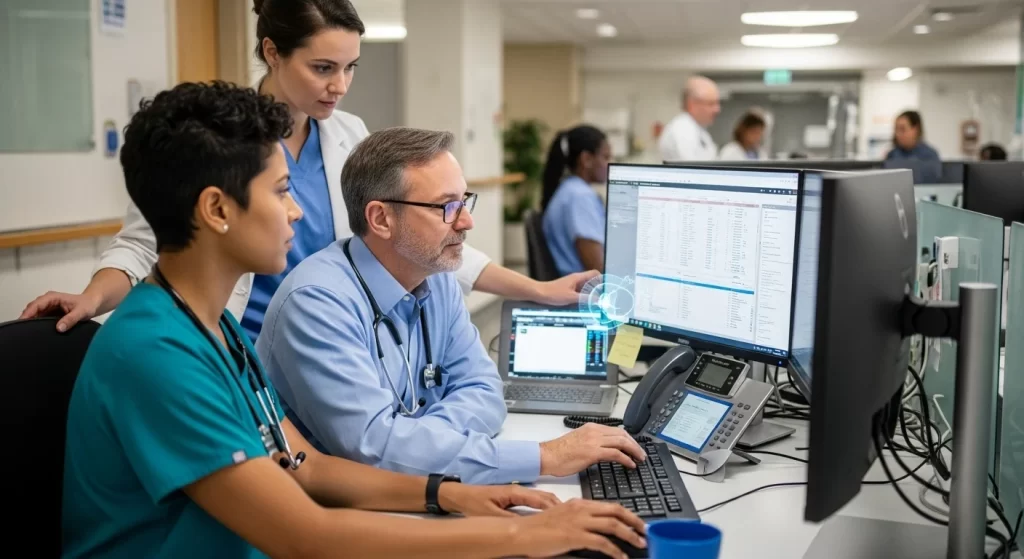Clinicians frequently face a demanding balance: providing patient care during work hours, then dedicating significant personal time to documentation—often termed “pajama time” or the “second shift.” This administrative burden strains clinical judgment and decision-making.
The documentation load is substantial. Physicians spend an average of 1.77 hours daily on clinical documentation outside office hours, totaling an estimated 125 million hours annually for US physicians. Primary care physicians, in particular, spend 36.2 minutes on EHRs per patient visit, with 6.2 minutes often extending into “pajama time.” For every hour of direct patient interaction, approximately 30 minutes are consumed by EHR documentation. Nurses, the largest group of EHR users, document 600-800 data points during a typical 12-hour shift.

It is an extensive time when the complexities and usability challenges of EHRs further exacerbate commitment. EHRs, intended to streamline workflows, often prioritize billing and compliance over intuitive clinical processes, resulting in inefficiency and clinician fatigue. Poorly designed interfaces, excessive data entry, and lack of standardization contribute to extended charting and dissatisfaction.
The consequences are far-reaching: escalating clinician burnout and attrition compromised patient safety due to rushed or delayed documentation, and significant economic drain on healthcare systems.
A transformative solution is emerging: the AI doctor note. This technology, powered by ambient AI and Natural Language Processing (NLP), automates clinical documentation, reduces errors, and frees clinicians from repetitive keyboard tasks. It integrates seamlessly into existing workflows, reclaiming time and improving well-being.
| Metric | Quantification |
|---|---|
| Average Daily/Weekly Hours on After-Hours Documentation | 1.77 hours/day (physicians); 125 million hours/year (US physicians); 6.2 minutes/visit “pajama time” (primary care) |
| Average Minutes on EHR Documentation per Patient Visit | 9 minutes/patient (overall); 36.2 minutes/visit (primary care); 16 minutes 14 seconds/encounter |
| Percentage of Workweek on EHR Documentation | ~25% of typical work week; 30 minutes for every hour with patients; 5.8 hours per 8 hours of patient care |
| Clinician Burnout Rates | 48.2% in 2023 (physicians); up to 50% (behavioral health); 38% (nurses); 71% believe EHRs contribute to burnout |
| Cost of Clinician Burnout/Turnover | $4.6 billion/year (US healthcare system); $500,000-$1 million+ per physician turnover; >$40,000 per bedside nurse turnover |
| Financial Losses from Inefficiency/Administrative Complexity | $202 billion/year (inefficient workflows); $265.6 billion/year (administrative costs); 30% of healthcare spending ($760-$935 billion annually) considered wasteful |
This article will explore the documentation crisis, the workings of doctor note AI, its transformative benefits, implementation considerations, and future implications.
Reach efficiency and clinician well-being. Our proven expertise in developing advanced AI doctor note solutions offers a future free from after-hours charting!
The Documentation Dilemma: Why After-Hours Charting is an Epidemic
The persistent challenge of after-hours charting has become a widespread crisis in healthcare, driven by EHR complexity, regulatory demands, and their profound consequences on clinicians and the healthcare system.

The Anatomy of After-Hours Work
Clinicians’ extensive after-hours documentation is a direct result of systemic pressures and technological shortcomings.
EHR Complexity and Data Entry Overload
EHRs, intended to streamline workflows, often contribute to the documentation burden. Poorly designed interfaces are characterized by clunky navigation, excessive clicks, “option overload,” slow charting and introduced redundancies. Clinicians report that challenging software leads to frustration, increased documentation time, and higher error rates. Lack of standardization, especially for chronically ill patients with multiple providers, creates inefficiency.
The volume of data entry is overwhelming; physicians spend an average of 16 minutes and 14 seconds on documentation per patient encounter. That limits direct patient interaction, contributing to burnout. EHR design often prioritizes data capture for billing and compliance over intuitive clinical workflow, creating a paradoxical situation where efficiency tools instead contribute to the administrative crisis, forcing clinicians into “second shifts.”
Regulatory Demands and Billing Specificity
Compliance requirements add a substantial layer of documentation burden. Healthcare organizations must adhere to complex local, state, and federal laws, including the Health Insurance Portability and Accountability Act (HIPAA) and the General Data Protection Regulation (GDPR), as well as specific billing regulations such as CPT codes and documentation of medical necessity. CMS holds providers responsible for complete, accurate, and timely documentation, warning that incomplete records can lead to unintended or dangerous outcomes.
Errors identified by the Comprehensive Error Rate Testing (CERT) program often stem from insufficient or illegible records, such as incomplete progress notes, missing signatures, or lack of documentation for medical necessity (e.g., physical therapy, E/M services, diagnostic tests, DME). The constant need to meet evolving compliance standards, which are frequently updated, places significant pressure on providers. While CPT E/M changes aim to reduce the burden by simplifying code selection and focusing on medical decision-making or total time, the necessity for detailed, verifiable records for payment and legal protection remains a significant driver of charting volume.
The Far-Reaching Consequences
The cumulative effect of documentation burden extends beyond individual clinicians, impacting the entire healthcare ecosystem.
Escalating Clinician Burnout and Attrition
Administrative burden is a primary driver of clinician burnout and attrition. In 2023, 48.2% of physicians reported burnout symptoms. Up to 50% of behavioral health clinicians and 38% of nurses report moderate to severe burnout. A significant 71% of doctors believe EHRs contribute to their burnout.
Burnout manifests as emotional exhaustion, depersonalization, and reduced personal accomplishment, leading to physical symptoms, absenteeism, and high turnover. The national turnover rate for bedside nurses increased from 16.8% in 2019 to 18.7% in 2021. Physician turnover rates are around 6-7% annually. The financial implications are staggering: burnout costs the U.S. healthcare system an estimated $4.6 billion annually, mainly due to physician turnover and reduced work hours. Each physician leaving due to burnout can cost an organization between $500,000 and over $1 million and more than $40,000 per bedside nurse.
Compromised Patient Care and Safety
Rushed or delayed documentation, a direct consequence of after-hours charting significantly impacts patient safety and the quality of care. When physicians are mentally exhausted from prolonged screen time, their ability to process, recall, and make decisions declines, which can lead to increased diagnostic errors. Tired physicians may overlook critical data, leading to missed diagnoses or delayed treatments.
Burdensome documentation is associated with an increased risk of medical errors and mistakes. Excessive “copy and paste” practices, a coping mechanism, can introduce inaccuracies and spread outdated information, masking essential clinical details. Mistakes in documentation, coordination, and communication are among the top 10 root causes of patient safety incidents in some healthcare systems. The diversion of clinician attention from direct patient care to computer screens compromises the patient-provider relationship and the quality of care.
The Economic Drain on Healthcare Systems
Inefficiencies from documentation issues impose a substantial financial burden. Approximately $202 billion is lost annually due to inefficient workflows. Administrative complexity accounts for around $265.6 billion in waste annually, with U.S. healthcare administration costs significantly higher than in other developed nations. This waste diverts resources from direct patient care.
Beyond direct administrative costs, documentation issues lead to financial, legal, and compliance risks for hospitals. Inaccurate or incomplete documentation is a leading cause of denied claims, accounting for approximately 40% of medical billing errors. Payer denials are a growing crisis, with an estimated $20 billion spent annually to overturn half of initially denied claims. Poor documentation can also weaken a hospital’s defense in legal cases, potentially leading to unfavorable outcomes and substantial financial losses. These financial losses, coupled with high costs associated with clinician burnout and turnover, underscore the urgent need for solutions that mitigate documentation burdens and enhance operational efficiency.
The AI Doctor Note: A Paradigm Shift in Clinical Documentation
The AI doctor notes fundamentally transform clinical documentation, offering a powerful solution to entrenched challenges. It leverages sophisticated AI to automate and streamline note creation, directly addressing documentation burden and clinician burnout.

Understanding the Core Technology Behind Doctor Note AI
The capabilities of an AI doctor note system are built upon advanced AI methodologies that interpret, process, and generate clinical information.
From Ambient Listening to Structured Data
Ambient AI forms the foundation of modern AI-driven note systems, utilizing voice recognition to capture patient-clinician conversations in real time passively. This hands-off approach allows for a natural conversation flow and maximizes patient focus.
Natural Language Processing (NLP) then converts spoken words into accurate, structured clinical notes. Medical NLP systems are trained to understand complex medical language, distinguish terms, interpret abbreviations, and recognize clinical context. They identify and extract entities such as diseases, medications, and symptoms, filtering out irrelevant chatter. That transforms unstructured data into organized, searchable information for EHR integration.
The Role of Large Language Models (LLMs) in Note Generation
Large Language Models (LLMs) are integral to AI-powered doctor notes. These AI systems analyze vast amounts of unstructured text (clinical notes, lab reports, medical literature) and generate human-like text. In clinical documentation, LLMs analyze conversations, summarize points, extract entities, and generate comprehensive notes.
Key LLM functionalities:
- Summarization: Condenses lengthy conversations or records into concise summaries, retaining critical details.
- Entity Extraction: Identifies and extracts key medical entities (diagnoses, medications, procedures) with high accuracy.
- Context Understanding: Interprets word meaning based on clinical context, differentiating ambiguous phrases.
- Content Generation: Generates various clinical documentation forms (SOAP notes, discharge summaries) by synthesizing encounter and patient data. LLMs can be fine-tuned on medical datasets for domain-specific jargon and structure.
Key Capabilities of an AI Doctor Note Agent
An advanced AI doctor note agent offers a suite of capabilities to revolutionize clinical documentation workflows.
Real-Time Scribing and Auto-Population
AI doctor notes create documentation in real-time during patient visits, acting as an “AI-powered medical scribe.” Clinicians can focus on the patient while AI captures the conversation and drafts the note. The system generates structured, diagnosis-aligned notes using existing patient data and automatically populates fields directly into the EHR. This seamless integration eliminates the need for manual note-taking, allowing physicians to be more present.
Intelligent Summarization and Contextual Extraction
Doctor note AI excels at intelligent summarization, condensing lengthy conversations or records into concise, meaningful summaries. It accurately extracts key medical entities like diagnoses, medications, and procedures. That improves decision-making and streamlines chart review. While “hallucinations” (inaccurate information) can occur, advanced systems use human-in-the-loop validation to minimize them.
Streamlining Orders, Referrals, and Follow-ups
AI doctor note technology assists with post-visit administrative tasks. Systems can analyze encounters to draft or suggest orders, referrals, and follow-up instructions. For example, an AI doctor note agent can listen for clinical intent and automate actions like queuing prescriptions or ordering labs. This streamlines workflows, reduces manual tasks and helps ensure continuity of care.
Voice-to-Text Accuracy and Medical Vocabulary
Accuracy of voice-to-text is paramount. While general speech recognition is 70-80% accurate, specialized medical dictation tools and AI doctor note systems are trained on vast medical datasets for higher accuracy. These systems handle specialized medical terminology, jargon, and accents, distinguishing similar-sounding terms and abbreviations. Some vendors claim 95-98% accuracy, with hybrid human-AI approaches boasting over 99% accuracy in medical transcription. This high accuracy is critical for patient safety and reliable documentation.
Transformative Benefits of AI Doctor Notes
The adoption of AI doctor note technology promises a profound transformation across the healthcare landscape, delivering quantifiable benefits to clinicians, patients, and the operational efficiency of healthcare systems.

Reclaiming Clinician Time and Focus
A significant benefit is the substantial reduction in documentation time. Case studies show hours saved:
- The Permanente Medical Group (TPMG) saved physicians the equivalent of 1,794 working days (nearly five years of work hours) in one year.
- Physicians using AI doctor note systems saw statistically significant reductions in note-taking time outside regular hours and time spent per appointment.
- One family nurse practitioner slashed documentation time from 30-60 minutes to under 5 minutes per note. Another practice reduced note-writing from 20-30 minutes to 3 minutes.
- A multi-specialty clinic study reported a 72% reduction in after-hours work.
- Ambient AI reduced note time per appointment at Sutter Health from 6.2 to 5.3 minutes.
- Overall, AI-driven documentation can shrink documentation time by up to 70%.
This reduction directly translates to enhanced patient engagement. By eliminating manual note-taking, AI doctor note technology allows clinicians to be more present and attentive. Patients notice this, with 47% reporting less computer time and 39% more direct speaking time from their doctor. That improves patient satisfaction and fosters stronger relationships.
Boosting Clinician Well-being and Morale
Alleviating the documentation burden has a profound impact on clinician well-being. Studies have shown a decrease in burnout and an improvement in work-life balance with AI-driven doctor note systems. One report found that 60% fewer primary care providers reported burnout after using an ambient AI scribe, and 81% more felt satisfied with their work. Clinicians reported feeling less rushed and experiencing lower mental demands, resulting in a decrease in burnout rates (e.g., from 42.1% to 35.1%).
Freeing clinicians from administrative tasks enables them to focus on complex clinical problem-solving, professional development, or their personal lives. This re-prioritization enhances job satisfaction and empowers clinicians. It also aids retention and recruiting efforts, mitigating high turnover costs.
Elevating Documentation Quality and Compliance
AI doctor note systems significantly improve the accuracy, completeness, and consistency of clinical notes. By automatically capturing and structuring information, they reduce human error, transcription mistakes, or omissions. Some studies suggest AI-powered notes can include 22% more relevant findings than manual notes. Doctor note AI analyzes data for inconsistencies, further enhancing EHR accuracy.
AI doctor notes technology streamlines billing and coding, leading to more accurate and efficient processes, reduced denials, and faster reimbursements. AI-powered notes can automatically assign correct ICD-10 and CPT codes, detect mismatched billing, and flag deficiencies before claims submission. This automation significantly reduces manual coding errors (historically 10-20%), with AI doctor note solutions approaching nearly zero errors and achieving over 98% accuracy in some cases. For example, Geisinger Health System achieved 98% accuracy in coding radiology reports using AI, resulting in a 90% reduction in administrative costs. That leads to faster claims processing and improved revenue cycle management.
Enhancing Overall Healthcare Operations
Benefits extend to broader operational efficiencies and cost savings. By automating administrative tasks, providers can better allocate staff, reducing burdens and focusing on patient care. This optimization results in significant cost savings, including reduced administrative staff requirements, decreased reliance on paper documentation, and lower turnover costs. Auburn Community Hospital reported a 50% drop in discharged-not-final-billed cases and a 40% boost in coding productivity after implementing AI. An AI doctor’s note can also increase patient throughput, with some practices adding 1-3 extra patients per day or five patients per week.
Standardized, high-quality data from AI doctor note systems benefits healthcare analytics, population health management, and medical research. Structured data is easier to access, search, and organize, reducing human error in decision-making by up to 57%. It facilitates predictive analytics, identifying correlations, trends, and patterns to predict outcomes, track disease trends, and manage population health. This improved data quality supports evidence-based medicine, enhances clinical decision-making, and accelerates medical research.
Implementing AI Doctor Note Solutions: Challenges and Best Practices with SPsoft
The successful integration of AI doctor note solutions requires navigating challenges ranging from data security and accuracy to technical integration and user adoption. Strategic partnerships are critical.

Navigating the Implementation Landscape for Doctor Note AI
Deploying advanced AI-driven doctor note technology requires a multifaceted approach that addresses technical, regulatory, and human factors.
Data Privacy, Security, and Compliance (HIPAA, GDPR)
Data privacy and security are paramount, given the sensitive nature of Protected Health Information (PHI). Organizations must ensure strict compliance with HIPAA (U.S.) and GDPR (Europe). Critical security measures include robust encryption for data in transit and at rest, stringent access controls (e.g., role-based access controls), data minimization, and anonymization or pseudonymization. Detailed audit logs are crucial for ensuring accountability and detecting threats. Regular risk assessments and Business Associate Agreements (BAAs) or Data Processing Agreements (DPAs) with third-party vendors are crucial.
Mitigating Hallucinations and Ensuring Clinical Accuracy
A significant concern with AI doctor note solutions, especially those based on LLMs, is “hallucinations”—the generation of inaccurate or fabricated information. Such errors can lead to misdiagnosis and compromised patient safety. Strategies to mitigate risks include:
- Rigorous Validation and Testing: Extensive pre-deployment testing in simulated environments.
- Human-in-the-Loop (HITL) Validation: Clinicians review and validate AI-generated outputs before finalization. This feedback loop helps the system learn.
- Grounded AI and Retrieval-Augmented Generation (RAG): Integrating LLMs with external, curated data sources ensures responses are grounded in up-to-date, domain-specific knowledge and clinical guidelines. RAG systems pull relevant research, guidelines, and patient history to synthesize accurate summaries.
Integration with Existing EHRs and Legacy Systems
Integrating AI doctor note systems with diverse, often outdated EHR platforms presents considerable technical challenges. Many systems utilize proprietary software that is incompatible with universal standards, such as HL7 or FHIR, resulting in data silos. Legacy infrastructure often lacks necessary APIs or data export functions, making integration complex and costly. Vendor lock-in further exacerbates this.
Successful integration strategies include:
- Embracing Industry Standards: Implementing HL7, FHIR, and SNOMED CT ensures systems “speak a common language.”
- Utilizing Integration Engines and Middleware: These act as intermediaries, translating data between incompatible systems.
- Leveraging APIs: Modern EHR platforms increasingly support open APIs for seamless integration.
- Cloud-Based Platforms: Offer scalability, automatic updates, and built-in interoperability.
User Adoption, Training, and Workflow Adaptation
The successful adoption of doctor notes AI hinges on practical clinician training and effective change management. Clinicians may be skeptical about the impact of AI on autonomy. It’s crucial to frame AI as a tool that enhances human capabilities.
Best practices for user adoption:
- Comprehensive, Role-Specific Training: Hands-on training demonstrating benefits and practical use.
- Human-Centered Design (HCD): Involve clinicians throughout the design process to ensure the solution aligns with workflows and enhances the user experience. That identifies pain points and ensures genuine empowerment.
- Phased Implementation: Start with pilot programs to build confidence and gradually scale.
- Clear Communication and Change Champions: Transparent communication and “super-users” help overcome resistance.
SPsoft’s Expert Approach to Your AI Doctor Note Journey
SPsoft offers a specialized and comprehensive approach to developing and implementing AI doctor note solutions.

Custom Development and Fine-tuning for Specific Needs
SPsoft emphasizes a custom approach, recognizing that off-the-shelf products often fail to capture the unique nuances of medical specialties or documentation styles. Custom development ensures the AI doctor note agent is built around an organization’s specific workflows and goals. SPsoft can tailor LLMs by fine-tuning them with domain-specific datasets, adapting the model to understand medical terminology and generating accurate responses for particular specialties. This bespoke approach provides greater control, superior accuracy, and a competitive advantage.
End-to-End Secure and Compliant Implementation
SPsoft embeds compliance and security at every stage of the AI doctor note development and deployment. The process begins with a needs assessment and strategic planning, identifying the types of PHI. SPsoft designs data flows with security in mind, implementing end-to-end encryption, strict access controls, and data minimization. Secure APIs and interfaces ensure that authenticated requests and validated data are processed.
During AI model training, SPsoft prioritizes the use of de-identified or anonymized data, ensuring secure environments when real PHI is involved. The company adheres to secure software development practices, including regular code reviews and continuous monitoring post-deployment. Compliance with HIPAA and GDPR is foundational, with SPsoft capable of building Software as a Medical Device (SaMD) solution in line with ISO 13485 and FDA requirements. This “compliance-by-design” approach ensures patient safety, data integrity, and regulatory adherence.
Seamless Integration and Workflow Optimization
SPsoft prioritizes seamless integration into existing clinical workflows. The company develops healthcare AI solutions with interoperability in mind, ensuring compatibility with existing Electronic Health Record (EHR) and Electronic Medical Record (EMR) systems through the Fast Healthcare Interoperability Resources (FHIR) and Health Level 7 (HL7) standards. This technical expertise enables seamless data exchange, thereby preventing data silos.
SPsoft’s workflow optimization involves thorough needs assessment to identify bottlenecks and define automation goals, followed by phased implementation. By analyzing existing processes and leveraging AI to automate repetitive tasks, SPsoft helps redesign workflows to minimize redundancies and facilitate quicker data entry. This optimization allows professionals to focus on higher-value activities, improving productivity and reducing administrative burdens.
Collaborative Partnership and Human-Centered AI Design
SPsoft’s philosophy centers on empowering users through collaborative partnership and human-centered AI design. The company actively involves clinicians and staff in the design and development, recognizing their feedback is invaluable for practical, user-friendly solutions. That builds trust and reduces skepticism.
SPsoft’s human-centered design principles focus on understanding end-user needs to ensure solutions fit smoothly into workflows and enhance daily experiences. That involves creating user personas, testing scenarios, and rapid prototyping based on real data and user feedback. By fostering a culture where AI augments clinical judgment, SPsoft enables organizations to develop new capabilities that leverage AI’s strengths while enhancing human skills such as critical thinking, empathy, and problem-solving. This “AI-human synergy” is key to restoring joy in medicine.
The Future of Clinical Documentation: What’s Next for the AI Doctor Note
The trajectory of AI doctor note technology points towards increasingly sophisticated capabilities and an evolving regulatory landscape, cementing AI’s role in clinical documentation.

Emerging Capabilities and Innovations
The future of AI doctor note systems is characterized by advancements that will enhance their ability to process diverse data types, generate proactive insights, and interact more intuitively with clinicians.
Multimodal Doctor Note AI Agent
Future AI doctor note systems are expected to evolve into multimodal AI doctor note agents capable of processing and integrating diverse data types beyond text. That includes medical images (such as X-rays and MRIs), sensor data from wearable devices (including vital signs), and video recordings of patient interactions. Integrating these modalities will enable the creation of richer, more comprehensive clinical notes and a more holistic understanding of the patient’s condition. Technical challenges include representing and aligning heterogeneous data. However, potential benefits include enhanced diagnostic accuracy and improved clinical decision support.
Proactive Insights and Predictive Analytics
AI doctor notes are poised to leverage their comprehensive understanding of documented data to generate proactive insights and flags for clinicians. That could revolutionize patient care by identifying early signs of patient deterioration, flagging potential medication interactions, or suggesting preventative care. For instance, an AI doctor note agent could analyze real-time patient vitals, lab results, and notes to detect sepsis up to 48 hours before clinical signs, prompting earlier intervention.
While these predictive capabilities offer immense benefits, they also raise ethical considerations, particularly regarding bias in training data. Ensuring transparency in algorithms and maintaining human oversight will be critical.
Enhanced Interactivity and Explainable AI (XAI)
Future AI-driven note systems will likely enable more interactive querying and refinement of notes by clinicians. Clinicians could ask the AI doctor note agent to elaborate or clarify any points. The incorporation of Explainable AI (XAI) principles will be crucial, as it makes AI models more interpretable and transparent by revealing the reasoning behind generated summaries or extracted entities. This transparency is vital for accountability and for enabling providers to justify their reliance on AI doctor note tools.
Regulatory Landscape and Standardization
The rapid evolution of AI doctor note technology necessitates a responsive regulatory environment alongside a push for greater standardization and interoperability.
Evolving Guidelines for AI in Medical Devices
Regulatory bodies worldwide are developing frameworks for AI-powered medical documentation tools. In the U.S., the FDA has issued draft guidance for Artificial Intelligence-Enabled Device Software Functions (AI-DSF), emphasizing a comprehensive approach to the total product lifecycle. This guidance provides recommendations for marketing submissions, performance validation, risk management, and bias mitigation.
In Europe, the EMA and the MHRA (UK) are adapting medical device regulations to accommodate AI. The EMA’s guiding principles for LLMs emphasize the importance of safe data input, critical thinking, cross-checking outputs, and continuous learning. The MHRA is developing guidance, including ‘Project Glassbox,’ to address concerns about poorly interpretable AI. These evolving guidelines aim to strike a balance between innovation and public safety, requiring rigorous testing, validation, and ongoing monitoring.
Interoperability and Data Exchange Standards
The future of AI doctor note systems is deeply intertwined with achieving greater interoperability and standardized data exchange. AI’s ability to analyze vast patient data depends on consistent, high-quality information. Key data standards include:
- FHIR (Fast Healthcare Interoperability Resources): An emerging standard for structural interoperability, providing a standardized API for patient records and bulk data access.
- SNOMED CT (Systematized Nomenclature of Medicine – Clinical Terms): Comprehensive multilingual clinical terminology for documentation in EHRs.
- LOINC (Logical Observation Identifiers Names and Codes): Standardized terminology for laboratory and clinical observations.
AI doctor note systems will play a pivotal role in the broader adoption and accurate implementation of these standards. NLP techniques can map medical text to standardized terminologies, and AI can extract structured entities from free text, enhancing data compatibility. This automation of standardization creates a virtuous cycle.
Global Adoption and Policy Implications
Global adoption of AI doctor note solutions is accelerating, driven by the need for personalized medicine and value-based care. The global AI in healthcare market is projected to reach USD 187.7 billion by 2030. North America dominates due to superior IT infrastructure and supportive government policies.
Challenges include financial concerns, immature AI tools, and regulatory uncertainty. Policy implications are significant, as governments must prioritize equity literacy and critical engagement to prevent inequities in digital healthcare. While AI-driven note solutions promise to extend quality care, their implementation must address data security, cost-effectiveness, and the preservation of the patient-provider relationship. The future will focus on developing globally relevant datasets for AI-driven doctor note solutions that serve diverse populations.
Conclusion
The pervasive burden of after-hours charting has long been a critical challenge in healthcare, contributing significantly to clinician burnout, compromised patient care, and economic inefficiencies. The emergence of AI-driven note-taking technology represents a fundamental paradigm shift poised to alleviate this administrative strain.
The profound positive impact of AI doctor notes is dual-faceted. Firstly, it significantly enhances clinician well-being by reclaiming invaluable time previously lost to “pajama time” documentation. This reduction in administrative burden directly correlates with decreased burnout rates, improved job satisfaction, and a renewed focus on the core mission of patient care. Secondly, it enhances the quality of patient care by enabling clinicians to be more present and engaged during visits, thereby fostering stronger patient-provider relationships. Simultaneously, it enhances documentation accuracy and completeness, streamlines billing processes, and provides higher-quality data for analytics and research, resulting in improved operational efficiencies and cost savings across healthcare systems.
Navigating the implementation of such advanced technology requires expertise in data privacy, mitigating AI “hallucinations,” seamless integration with legacy electronic health records (EHRs), and effective user adoption strategies. SPsoft stands as a strategic partner in this transformation, offering custom AI doctor note solutions that are meticulously developed, fine-tuned for specific medical needs, and implemented with end-to-end security and compliance. SPsoft’s human-centered design approach ensures that the doctor note AI agent empowers clinicians, optimizes workflows, and genuinely enhances the daily experience of healthcare professionals.
Are you ready to empower your staff, boost efficiency, and promote the future of documentation? Learn how our custom AI doctor note solutions can help you thrive!
FAQ
What exactly is an AI doctor note, and how does it work?
An AI doctor note is a tool that utilizes ambient AI and Natural Language Processing (NLP) to automatically transcribe patient-clinician conversations into structured clinical notes. It captures the dialogue in real-time, understands medical terminology, and integrates the information directly into the Electronic Health Record (EHR). That eliminates the need for manual typing, allowing clinicians to focus entirely on the patient.
Is “pajama time” charting that big of a problem for doctors?
Yes, it’s a significant issue. Physicians spend an average of 1.77 hours daily on documentation outside of work hours, a practice often referred to as “pajama time.” This “second shift” contributes heavily to burnout, with over 70% of doctors believing EHRs are a major cause. This administrative overload strains clinical judgment, reduces time for patient care, and leads to high rates of attrition in the medical field.
Will AI replace the need for clinicians to review their notes?
Not entirely. While AI significantly reduces manual work, clinician oversight remains crucial. Advanced systems use a “human-in-the-loop” validation process where clinicians quickly review and confirm the AI-generated notes. That ensures clinical accuracy and helps mitigate the rare risk of AI “hallucinations” or errors. The goal is to augment clinical intelligence, not replace it, ensuring patient safety and accountability.
How much time can clinicians save with an AI doctor note?
The time savings are substantial. Studies show AI can slash documentation time by up to 70%. For instance, one nurse practitioner cut her note-taking from over 30 minutes to under 5 minutes per patient. A multi-specialty clinic even reported a 72% reduction in after-hours charting. This reclaimed time enables better patient engagement and can even create opportunities to see more patients each day.
Can AI doctor notes improve patient care?
Absolutely. By freeing clinicians from the computer screen, AI enables more direct and focused interaction with patients. Patients report that their doctors spend less time on the computer and more time speaking with them. That enhances the patient-provider relationship and satisfaction. Furthermore, AI can enhance documentation accuracy, resulting in fewer medical errors and more informed clinical decisions, which directly improve the quality and safety of care.
Are AI-generated notes accurate and compliant?
High-quality AI doctor note systems are designed for accuracy and compliance. They use specialized medical vocabularies to achieve over 98% accuracy in transcription and coding. These tools streamline billing by automatically assigning correct codes, reducing denial rates. They also ensure that notes are complete and adhere to regulatory standards, such as HIPAA, which can strengthen a hospital’s legal and financial standing by preventing costly documentation errors.
What are the biggest challenges when implementing this technology?
The main hurdles include ensuring data privacy and HIPAA compliance, integrating the AI with existing and often outdated EHR systems, and managing user adoption. Clinicians may be skeptical, so practical, role-specific training and involving them in the design process are key. It’s also vital to have strategies to mitigate potential AI errors, ensuring that the technology is a trustworthy and seamless addition to the clinical workflow.
How does this technology impact clinician burnout?
AI doctor notes directly combat burnout by tackling one of its primary causes: administrative overload. By automating documentation, it eliminates the dreaded “pajama time,” giving clinicians their time back. Studies show significant improvements in work-life balance and job satisfaction. For example, one report found that 60% fewer primary care providers reported burnout after adopting an ambient AI scribe tool.
What’s the future of AI in clinical documentation?
The future is moving towards a multimodal AI doctor note agent that can process not only conversations but also medical images and data from wearable devices, providing a more holistic patient view. We can also expect more proactive insights, where the AI flags potential health risks or suggests preventative care based on the documentation. Enhanced interactivity and explainable AI (XAI) will make these tools more transparent and user-friendly, thereby improving their usability.
How can a medical practice get started with an AI doctor note solution?
The best approach is to partner with a specialized developer, like SPsoft, for a custom solution. A tailored system ensures the AI aligns with your specific workflows and medical specialty needs. The process involves a needs assessment, designing a secure and compliant system, seamless integration with your current EHR, and providing human-centered training to ensure your team is confident and ready to embrace the future of documentation.



